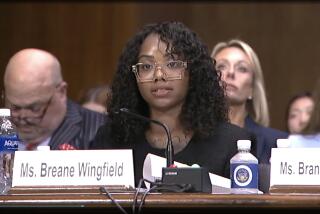The ‘repugnant, vile truth’ about sex trafficking in L.A. County

- Share via
“When I turned 14, that was when I hit the track.”
The track, as Jessica Midkiff calls it, was Sunset Boulevard in Hollywood, where she trolled for johns and turned every cent of her earnings over to the pimp who owned her.
If you tried to skim a dollar here or there, Midkiff said, or if you got arrested and ratted out your pimp, you or someone in your family was likely to be beaten or tortured.
“When a pimp says he’s going to torture you, what I’ve seen is girls in dog cages, girls being waterboarded, stripped down naked and put in the rain and cold outside and having to stand there all night, and if you move, you’ll get beaten. I’ve seen girls get hit by cars and stunned with stun guns … I’ve seen girls burned and strangled.”
Midkiff lived this life for far too long but managed to make a break at 21. Today, at 28, she’s working to help steer other girls out of the trade.
Sex trafficking is big business in Los Angeles County, and underage girls by the hundreds are lured or forced into service. Between 2010 and 2012, according to the county Probation Department, 555 juveniles were arrested for prostitution-related offenses. Authorities believe far, far more are never caught.
In an effort to protect underage girls, county Supervisors Mark Ridley-Thomas and Don Knabe will introduce a motion calling for a crackdown on johns, making solicitation of a minor a felony rather than a misdemeanor, raising the fine from $1,000 to $10,000, seizing property if necessary to pay the fine, and making the names of the johns public.
“This is simply intolerable, and we need to stop calling these girls prostitutes and call it what it is: statutory rape,” Ridley-Thomas told me Friday. The average age of juveniles entering “this horrible life” is 12, he said.
“That’s the repugnant, vile truth,” the supervisor wrote in a prepared statement, adding that “children are being forced to have sex with 10 or 12 men a day, every day of the week. Girls are being beaten, drugged, starved and even branded … while all too often the child predators walk away scot-free.”
Michelle Guymon, who runs a sex trafficking unit for the Probation Department, told me she underwent a dramatic change in perspective on the girls caught up in this life after getting to know them.
“I always made a judgment about them; I thought it was their choice,” she said. “I didn’t realize the exploitation and coercion involved.”
It was easier to view the 17- and 18-year-old girls as responsible for their own actions, she said. But she discovered they had been involved in the trade for years, having started as runaways from abuse, broken families and foster homes.
“When I came across my first 10- and 11-year-olds, I thought, ‘There’s no way this was a choice.’ You don’t wake up one day and say this is what you want to do with your life.”
Catherine Pratt, a commissioner in Compton Juvenile Court, said the vast majority of girls who come into her courtroom on prostitution-related offenses are African American and from the county’s poorest communities. She started a program two years ago to direct girls into housing and provide counseling and mentoring in hopes of helping them break free of the business. Pratt has seen some successes, but the challenge is great.
“I would say the majority of the girls are with pimps, and those pimps are affiliated with gangs,” said Pratt, who said it’s her understanding that the gangs make as much money from selling young girls as they do from selling drugs.
Many of the girls believe that giving police any information about their pimps could get them killed, said Pratt, and that has “a chilling effect” on their willingness to cooperate. Pratt recalled a case last year in which a girl was badly injured, perhaps for talking.
“She was run over, she thinks by her pimp, and had her whole leg shattered,” said Pratt. “She has rods in her leg and is still healing, and many of her teeth were knocked out. No one was prosecuted for it.”
Jessica Midkiff is now in college while working as a consultant for county probation, where she shares her story with girls who live in the hell she once lived in. When she’d finally had enough, after more than a dozen arrests for prostitution-related offenses, she got help from the Mary Magdalene Project, a Van Nuys nonprofit that helps exploited women start new lives.
There was a lot for Midkiff to work through, and some of the work remains. She said she was abandoned by her father, then abused by her stepfather and by neighborhood men in South Los Angeles before walking the streets at 14.
“The culture is, ‘You don’t tell,’” she said. “What happens in this house stays in this house or you might get killed.”
She had a break with her mother, hung out with “the wrong crowd,” then fell in with a string of pimps who either showered her with compliments, paralyzed her with fear — or both. Each one “branded” her, she said, showing me the tattoos on her neck and arm.
“It’s modern-day slavery is all it is,” she said. “If you want to use the restroom, you have to ask. If you want to eat, you ask, and if you don’t get permission, you just don’t do it. It’s more than physical domination. It’s emotional and mental, and that’s the domination that tends to linger.”
More to Read
Sign up for Essential California
The most important California stories and recommendations in your inbox every morning.
You may occasionally receive promotional content from the Los Angeles Times.











